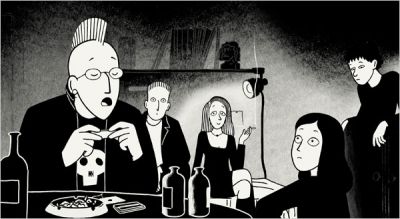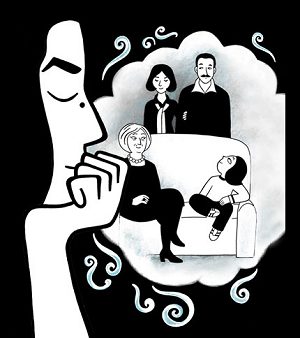Serendip is an independent site partnering with faculty at multiple colleges and universities around the world. Happy exploring!
Notes Towards Day 15: "Doing Justice"
II. English Majors' Tea Thurs. Oct. 30 @ 4 (w/ costumes!)
(help--a sheet of paper w/ 2 "descriptives" of my courses...?
switching to theory for a while
20 pp. essay by Martin and Mohanty. “Feminist Politics:
What’s
Home Got to Do with It?”
Two essays/35 pp. from Asian American Sexualities:
"Home Bodies and the Body Politic" and "Maiden Voyage"
question on the forum this week has to do with "what
home has to do with" with feminist/identity politics
first essay is classic, lays out the issues;
second two are contemporary applications,
so focus on the first
not easy to read: an interpretation of a story you haven't read,
but models "feminist reading" in a very useful way
see how feminists write about literature:
a model for doing criticism/theory
Hilary anticipated this theme of "home," w/ her mention of the Baba-Levys in Persepolis: They are a Jewish family
living in Iran, and while many other Iranians are fleeing the county,
they stay because it is their home.
intersection of 'home' and politics.
A story about this, from the Gender & Sexuality panel last week:
I didn't understand "heterflexible" (vs. "bisexual") and was told
"If you were in the community, this would make perfect sense."
(felt silenced/excluded from the conversation/which stopped...)
As you do this reading, be thinking about your second paper,
due in 2 1/2 weeks, on Friday November 14
Focusing on the Local:
what gender-related issues interest you most
in one particular site in the world?
How are they being represented?
How might those representations be altered?
What interventions are needed?
Tamar Lewin. "'Sisters' Colleges See a Bounty in the Middle East."
jzarate: I’m completely bummed that we did not discuss the article about sexual reassignment in Iran....the article does not do give enough cultural background to the strict enforcement and division between those who are physically “male” and those who are “female”. In the Islamic faith, there is an important division of the sexes...based on the idea that Allah creates in...binary opposites. Therefore deviation...is seen as dangerous....genders are divided by their sexual roles, the penetrator and the penetrated....This leads me to consider...how different religious and cultural standards have shaped our views and definitions of licit and illicit sex
kgbrown: Bryn Mawr is considering constructing a branch of BMC in the
UAE...I was very
excited about the idea of spreading Bryn Mawr to other parts of the
world. But...I wonder whether ..a branch of Bryn
Mawr in the UAE... will be just be a method for maintaining the traditional
female roles of Muslim society....I would not support putting
Bryn Mawr's name on an institutution that is not in support of breaking
down the structure of gender roles and gender identity.
from an alum living in Syria, whose sister decided not to come to Bryn Mawr: "I did not want to go to an all-women's college. I just don't like the idea of separating people and living in an exclusively unisex atmosphere. I don't see the reason for it. It's like when you go to a Ramadan feast and all the women are on one side of the room and all the men on the other --- why can't they interact? Why can't they even pray side by side?"
cannot image the world beyond the village...cannot read:
"She is living a very traditional life. She has no rights...
her ideas are very small."
between a woman's college and the sex-segregation
practices common in the Middle East?

II. All a context for Persepolis: The Story of a Return
I
was struck immediately by the
form and content of the introduction....Satrapi provides not only a
history lesson but an
autobiographical lesson....Satrapi’s language in this introduction
suggests that...her project is in this graphic novel: to do justice.
Allegories of Transexuality":
how do justice to linguistic fragments of something called a person?
language already "going on," saturated with norms, predispositions
"one speaks a language that is already speaking":
see self through a set of expectations of a "norm"
does justice demand deferral?
on refusing to be reduced to/exceeding a body part
incommensurability between who he is/what he has:
derives his worth from the gap, in the ways he is
not recognizable/categorizable: self beyond discourse
How might (the reductive? black-and-white
form of the?) graphic novel "do justice"?
How might it fail to?
mpottash: do illustrations allow for the
better expression of our inner ideas?...perhaps it
is this aspect that would allow us to call a graphic novel "feminist":
perhaps it allows the author to express ideas that would otherwise not
be expressed
BUT-->
...One thing that struck me was how much watching or gazing went on in the story....I interpreted this as a theme of control. I also think it is interesting to see that a person wasn't allowed to 'gaze' back
egleichm: Persepolis was immediately very jarring for me....we are lucky enough to gain access to the imagination of a kid [but]...how could murder, oppression, rape be shaped into a form that I am used to laughing at? And how is it feminist to present atrocities in a way that challenges conventions?...a juxtaposition of jest (the art) and tragedy (the words)...

In this particular form?
then self-organize/
sign up for a small group
(no more than three people/per...)
Top-down questions re: "doing justice"
OR
bottom-up constructions about....
Work for 15 minutes;
illustrating your general thinking with
one or two specific pages of the text
(could be news articles as well as graphic novel).


